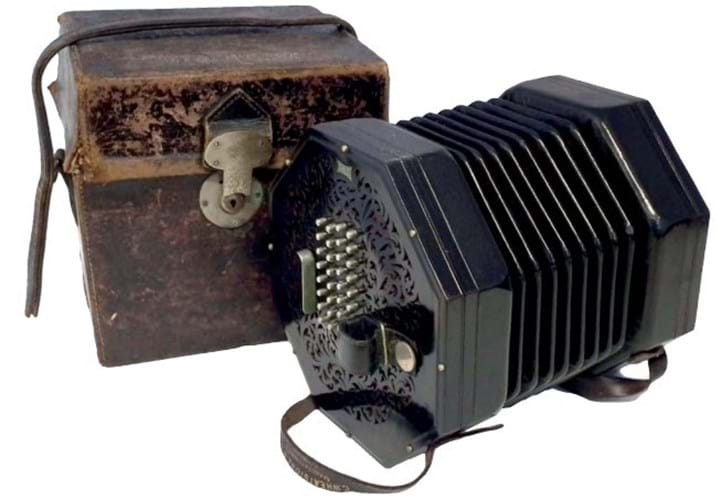
There was ample evidence of this at Peter Wilson’s (24% buyer’s premium inc VAT) fine art sale in Nantwich on July 5-6 when a cache of a dozen concertinas, sent for sale by a family from Penrith, sold to players and collectors from the UK and continental Europe for a total of £21,000.
Specialist Chris Large – himself a musician and a maker of string instruments as well as an auctioneer – described the 12 concertinas as ‘barn finds’. “The owner was an avid auction buyer and something of a hoarder,” he said. “We’ve since found another Wheatstone and a vintage Alvis buried under detritus in an outbuilding.”
All concertinas assume the same basic ‘squeeze box’ design but most players focus on one of three distinct types: the English, the Anglo-German or the duet.
English concertinas – as invented by leading maker Charles Wheatstone in 1829 – produce the same note when a key is pressed, regardless of whether the bellows are expanded or compressed. The classic model has 48 keys, but other more sophisticated issues offer more notes, chords and the occasional duck quack or a flatulence key to add a little humour.
Leading this collection at £5400, well above its £700-1000 estimate, was a Wheatstone Aeola, pictured above. It is eight rather than six-sided, bigger than most at 9in (22cm) wide, and has 64 keys across its jet black endplates. The Wheatstone order books surviving in the Horniman Museum in south London show this instrument (serial number 30824) left the factory on December 16, 1925.
The Anglo-German concertina – hugely popular during the middle and late 19th century – works more like a mouth organ, giving different notes when the bellows are ‘in’ and ‘out’. Charles Jeffries is the premier name. An itinerant brushmaker and an aspiring musician in his younger days, by the 1860s Jeffries had turned first to repairing and then to making Anglo concertinas. His instruments – categorised according to the keys arranged in two, three or four rows – are much coveted by Irish folk musicians.
There were two Jeffries examples in this collection, each stamped to the pierced metal endplates C Jeffries. A 39 key ‘four-row’ Anglo sold for £4300, while a 32-button instrument sold for £3500.
Prices for the wares of Lachenal & Co – the firm established by the family of Louis Lachenal who had supplied concertinas to Wheatstone – are generally at a lower level. A classic English 48-key model with the serial number 58581 sold for £260 while a 33-key ‘Peerless’ model made for the retailer John C Murdoch & Co (serial number 119094) took £750.
The Wheatstone concertina (a 48-key English model) from the same unlikely source will be sold in September with hopes of £700-1000.














